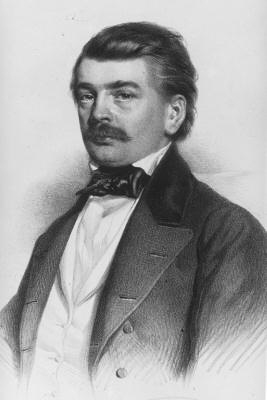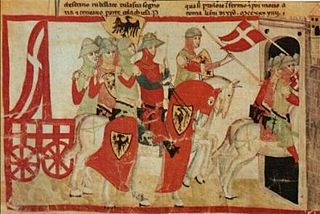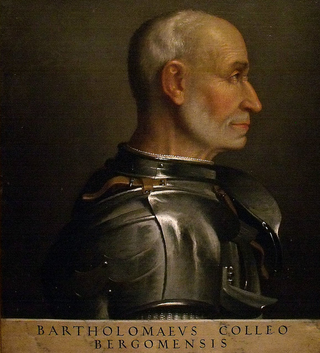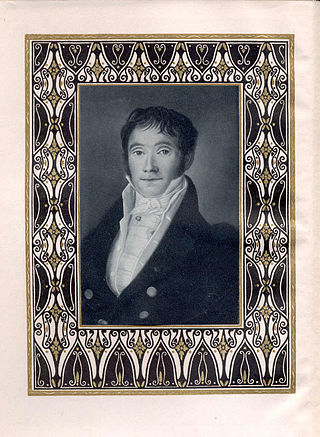
The Lombards or Longobards were a Germanic people who conquered most of the Italian Peninsula between 568 and 774.

Franz Miklosich was a Slovenian philologist and rector of the University of Vienna.
Mundus or Mundo was a Barbarian commander of Gepid, Hun, and/or Gothic origins. He appears to have been the son of the Gepid king Giesmus. In the early 500s he commanded a group of bandits in Pannonia, eventually allying himself to the Ostrogothic king Theodoric the Great. After Theodoric's death in 526, Mundus entered Byzantine service under emperor Justinian I, fighting in the Balkans, defending Justinian during the Nika riots, and fighting in the first stage of the Gothic War, during which he died in 536.

The Battle of Cortenuova was fought on 27 November 1237 in the course of the Guelphs and Ghibellines Wars: in it, Holy Roman Emperor Frederick II defeated the Second Lombard League.

The Battle of Montaperti was fought on 4 September 1260 between Florence and Siena in Tuscany as part of the conflict between the Guelphs and Ghibellines. The Florentines were routed. It was the bloodiest battle fought in Medieval Italy, with more than 10,000 fatalities. An act of treachery during the battle is recorded by Dante Alighieri in the Inferno section of the Divine Comedy.

The Battle of Curzola was a naval battle fought on 9 September 1298 between the Genoese and Venetian navies. It was a disaster for Venice, a major setback among the many battles fought in the 13th and 14th centuries between Pisa, Genoa, and Venice in a long series of wars for the control of Mediterranean and Levantine trade.
In historical Germanic society, nīþ was a term for a social stigma implying the loss of honour and the status of a villain. A person affected with the stigma is a nīðing . Middle English retained a cognate nithe, meaning 'envy', 'hate', or 'malice'.

In Gothic architecture, a wimperg is a gable-like crowning over portals and windows and is also called an ornamental gable. Outside of immediate architecture, the wimperg is also found as a motif in Gothic carving.

The Ten Days of Brescia was a revolt which broke out in the northern Italian city of that name, which lasted from 23 March to 1 April 1849.

The Battle of Bosco Marengo(aka Battle of Frascata) was fought in the autumn of 1447.

The Battle of Crevola was fought in the spring of 1487, between a marauding Swiss army from the Valais and Lucerne and troops from the Duchy of Milan, for the supremacy of the Val d'Ossola (Eschental).

The Five Days of Milan was an insurrection and a major event in the Revolutionary Year of 1848 that started the First Italian War of Independence. On 18 March, a rebellion arose in the city of Milan which in five days of street fighting drove Marshal Radetzky and his Austrian soldiers from the city.

The naval battle of Ponza was fought in early August 1435, when the Duke of Milan dispatched the Genoese navy to relieve the besieged town of Gaeta, which was currently under threat from the King of Aragon.

The Battle of Cassano was fought in the Autumn of 1259 between Guelph and Ghibelline armies in Northern Italy.
The Battle of Motta was fought in late August 1412 when an invading army of Hungarians, Germans and Croats led by Pippo Spano and Voivode Miklós Marczali attacked the Venetian positions at Motta in Italy and suffered a heavy defeat.

The sortie on Mestre occurred during the revolutionary year of 1848 on October 27.
Italian volunteers charged the Austrian fortification, took the town and withdrew, with the loot of three baggage-waggons, eight horses, large quantity of ammunition and the military chest, back to the fort at Marghera.

Benedictus Gotthelf Teubner was a German bookseller and the founder of a publishing company.

In 566, Lombard king Alboin concluded a treaty with the Pannonian Avars, to whom he promised the Gepids' land if they defeated them. The Gepids were destroyed by the Avars and the Lombards in 567. Gepid King Cunimund was killed by Alboin himself. The Avars subsequently occupied "Gepidia", forming the Avar Khaganate. The Byzantine Emperor intervened and took control of Sirmium, also giving refuge to Gepid leader Usdibad, although the rest of Gepidia was taken by the Avars. Gepid military strength was significantly reduced; according to H. Schutz (2001) many of them joined Lombard ranks, while the rest took to Constantinople. According to R. Collins (2010) the remnants were absorbed either by the Avars or Lombards. Although later Lombard sources claim they had a central role in this war, it is clear from contemporary Byzantine sources that the Avars had the principal role. The Gepids disappeared and the Avars took their place as a Byzantine threat. The Lombards disliked their new neighbours and decided to leave for Italy, forming the Kingdom of the Lombards.

Eduard Jacobson was a German dramatist and physician.

Ulrike Almut Sandig is a German writer. She was born in Großenhain in the former GDR, and has lived in Riesa, Leipzig and Berlin. She studied religious studies and indology at university, and then studied at the German Institute for Literature in Leipzig.

















